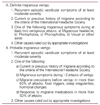References
1. Headache classification committee of the international headache society. Classification and diagnostic criteria for headache disorders, cranial neuralgias and facial pain. Cephalalgia 1988. 8S7. 1–96.
2. The international classification of headache disorders: 2nd ed. Cephalalgia 2004. 24S1. 9–160.
3. Lipton RB, Dodick D, Sadovsky R, Kolodner K, Endicott J, Hettiarachchi J, Harrison W. ID Migraine validation study. A self - administered screener for migraine in primary care: The ID Migraine validation study. Neurology 2003. 61375–382.
4. Neuhauser H, Leopold M, von Brevern M, Arnold G, Lempert T. The interrelations of migraine, vertigo, and migrainous vertigo. Neurology 2001. 56436–441.
5. Cass SP, Furman JM, Ankerstjerne K, Balaban C, Yetiser S, Aydogan B. Migraine-related vestibulopathy. Ann Otol Rhinol Laryngol 1997. 106182–189.
6. Eviatar L. Vestibular testing in basilar artery migraine. Ann Neurol 1981. 9126–130.
7. Olsson JE. Neurotologic findings in basilar migraine [Review]. Laryngoscope 1991. 1011–41.
8. Di Duro JO. Vestibular migraine: objective diagnostic criteria. Neuol Sci 2003. 2480–81.
9. Cutrer FM, Baloh RW. Migraine-associated dizziness. Headache 1992. 32300–304.
10. Johnson GD. Medical management of migraine-related dizziness and vertigo. Laryngoscope 1998. S 85. 1–28.
11. Savundra PA, Carroll JD, Davies RA, Luxon LM. Migraine-associated vertigo. Cephalalgia 1997. 17505–510.
discussion 487.
12. Slater R. Benign recurrent vertigo. J Neurol Neurosurg Psychiatry 1980. 42363–367.
13. Basser LS. Benign paroxysmal vertigo of childhood. Brain 1964. 87141–152.
14. Neuhauser H, Lempert T. Vertigo and dizziness related to migraine: A diagnostic challenge. Cephalalgia 2004. 2483–91.
15. Dieterich M, Brandt T. Episodic vertigo related to migraine (90 cases): vestibular migraine? J Neurol 1999. 246883–892.
16. Kayan A, Hood JD. Neuro-otological manifestations of migraine. Brain 1984. 107(Pt 4)1123–1142.
17. Kolev O. How caloric vestibular irritation influences migraine attacks. Cephalalgia 1990. 10167–169.
18. Furman JM, Marcus DA, Balaban CD. Migrainous vertigo: development of a pathogenetic model and structured diagnostic interview. Curr Opin Neurol 2003. 165–13.
19. Carmona S, Settecase N. Use of topiramate (topamax) in a subgroup of migraine-vertigo patients with auditory symptoms. Ann N Y Acad Sci 2005. 1039517–520.
20. Baloh RW, Foster CA, Yue Q, Nelson SF. Familial migraine with vertigo and essential tremor. Neurology 1996. 46458–460.
21. Abu-Arafeh I, Russel G. Paroxysmal vertigo as a migraineequivalent in children: a population based study. Cephalalgia 1993. 1522–25.
22. Bayazit Y, Yilmaz M, Mumbuc S, Kanlikana M, Assessment of. Assessment of migraine-related cochleovestibular symptoms. Rev Laryngol Otol Rhinol (Bord) 2001. 12285–88.
23. Harker LA. In : Baloh RW, Halmagyi GM, eds. Migraine associated vertigo. Disorders of the vestibular system 1996. Oxford: Oxford University Press; 407–417.
24. Kuritzky A, Ziegler DK, Hassanein R. Vertigo, motion sickness and migraine. Headache 1981. 21227–231.
25. Barabas G, Matthews WS, Ferrari M. Childhood migraine and motion sickness. Pediatrics 1983. 72188–190.
26. Radtke A, Lempert T, Gresty MA, Brookes GB, Bronstein AM, Neuhauser H. Migraine and Meniere's disease: is there a link? Neurology 2002. 591700–1704.
27. Ishiyama A, Jacobson KM, Baloh RW. Migraine and benign positional vertigo. Ann Otol Rhinol Laryngol 2000. 109377–380.
28. Lempert T, Leopold M, von Mrevern M, Neuhauser H. Migraine and benign positional vertigo. Ann Otol Rhinol Laryngol 2000. 1091176.
29. Lee H, Sohn SI, Jung DK, Cho YW, Lim JG, Yi SD, Yi HA. Migraine and isolated recurrent vertigo of unknown cause. Neurol Res 2002. 24663–665.
30. Margraf J, Taylor B, Ehlers A, Roth WT, Agras WS. Panic attacks in the natural environment. J Nerv Ment Dis 1987. 175558–565.
31. Breslau N, Schultz LR, Stewart WF, Lipton RB, Lucia VC, Welch KM. Headache and major depression: Is the association specific to migraine? Neurology 2000. 54308–313.
32. Breslau N, Schultz LR, Stewart WF, Lipton R, Welch KM. Headache types and panic disorder: Directionality and specificity. Neurology 2001. 56350–354.
33. Furman JM, Jacob RG. Psychiatric dizziness. Neurology 1997. 481161–1165.
34. Persoons P, Luyckx , Desloovere C, Vandenberghe J, Fischler B. Anxiety and mood disorders in otorhinolaryngology outpatients presenting with dizziness: validation of the self administered PRIME-MD Patient Health Questionnaire and epidemilology. Gen Hosp Psychiatry 2003. 25316–323.
35. Eckhardt-Henn A, Breuer P, Thomalske C. Anxiety disorders and other psychiatric subgroups in patients complaining of dizziness. J Anxiety Disord 2003. 17369–388.
36. Lance JW, Anthony M. Some clinical aspects of migraine. A prospective study of 500 patients. Arch Neurol 1966. 15356–361.
37. Drummond PD. Relationships among migrainous, vascular and orthostatic symptoms. Cephalalgia 1982. 2157–162.
38. Bes A, Dupui P, Guell A, Bessoles G, Geraud G. Pharmacological exploration of uiodopamine hypersensitivity in migraine patients. Int J Clin Pharmacol Res 1986. 6189–192.







